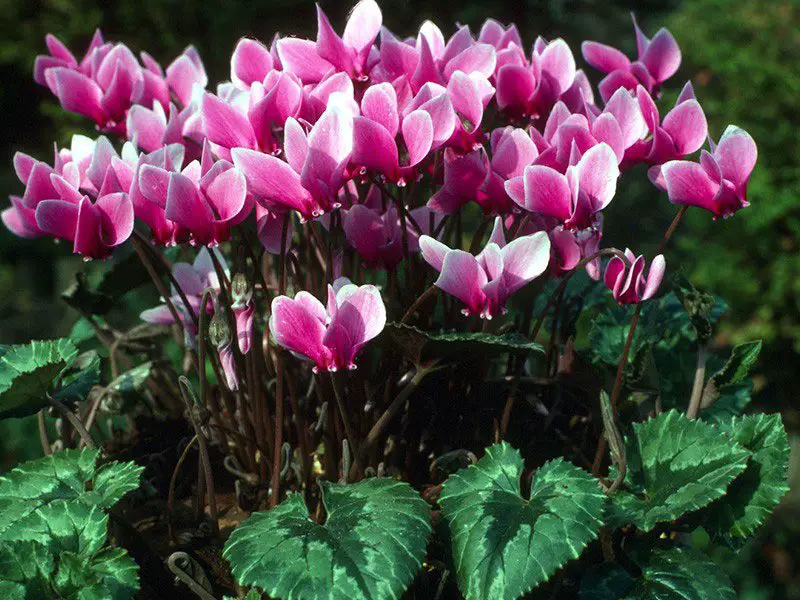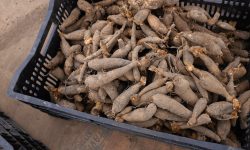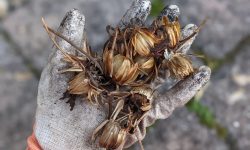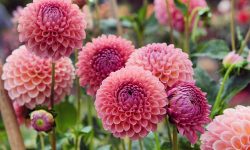Cyclamen are charming flowering plants known for their vibrant, upswept petals and marbled foliage. When grown in pots, especially indoors, they become delightful accent plants, bringing life to windowsills, tables, and shelves during the colder months. However, they require specific care to thrive and maintain their beauty over time.
Understanding how to care for cyclamen in pots is essential to ensure long-lasting blooms and healthy growth. With the right conditions, attention to detail, and seasonal care, cyclamen can become a rewarding part of your indoor plant collection.
Choosing the Right Cyclamen Variety for Pots

When selecting cyclamen for container growing, not all varieties are created equal. Some are specifically bred for indoor performance, with compact growth habits, longer blooming periods, and stronger resilience to varying indoor conditions. Florist cyclamen (Cyclamen persicum) is the most commonly chosen type for pots, especially during the fall and winter months. This variety boasts large, vibrant blooms and attractive marbled foliage, making it ideal as a houseplant.
Miniature cyclamen, or “mini-cyclamen,” are another excellent option for indoor pots. These hybrids are smaller, but they tend to last longer indoors and adapt more easily to container life. Their blooms are often more abundant, and they can thrive in smaller pots, making them perfect for windowsills and small spaces.
It’s also essential to check whether the cyclamen is a hardy or non-hardy type. Hardy cyclamens, such as Cyclamen hederifolium or Cyclamen coum, are better suited for outdoor gardens or cool greenhouses, while Cyclamen persicum should always be kept indoors in colder climates.
When buying, choose plants with plenty of unopened buds nestled just above the foliage. This indicates the plant will bloom for a longer time in your home. Avoid varieties that already have yellowing leaves or spent flowers, as they may be nearing the end of their cycle.
Selecting the right variety based on your indoor environment, pot size, and lighting will help ensure your cyclamen delivers stunning, long-lasting blooms throughout the season.
Selecting the Best Pot and Soil Mix
For healthy cyclamen in pots, choosing the right container and soil is crucial. Use a pot that has adequate drainage holes to prevent water from pooling at the bottom, which can lead to root and tuber rot. A breathable material like terra-cotta is ideal, as it allows excess moisture to evaporate more easily.
The soil mix should be light, airy, and well-draining. A high-quality potting mix designed for indoor plants or African violets works well. To enhance drainage, you can amend the mix with extra perlite, pumice, or coarse sand. Avoid heavy soils that retain too much moisture.
Cyclamen prefer slightly acidic to neutral soil with a pH around 6.0–7.0. The tuber should be planted with the top just slightly above the soil surface, allowing airflow and preventing rot. Proper pot and soil selection creates a stable foundation for your cyclamen to thrive indoors with vibrant blooms and healthy foliage.
Light Requirements for Indoor Cyclamen
Cyclamen thrive in bright, indirect light when grown indoors. Too much direct sun—especially during midday—can scorch their delicate leaves and cause flowers to fade quickly. Instead, place your potted cyclamen near an east-facing window where it receives gentle morning light, or a north-facing window with bright ambient lighting throughout the day.
If you’re growing cyclamen during the darker months of fall and winter, you can supplement with fluorescent grow lights or full-spectrum LED lights. Keep artificial lights about 12–18 inches above the plant and run them for 12–14 hours a day to simulate natural daylight conditions.
It’s also important to rotate the pot every few days so the plant grows evenly and doesn’t lean toward the light source. Avoid low-light areas such as hallways or shadowy corners, as insufficient light can lead to weak stems, fewer blooms, and yellowing leaves.
By providing the right balance of filtered sunlight and avoiding extremes, you’ll encourage robust foliage growth and a steady display of cyclamen flowers indoors.
Watering Techniques for Healthy Growth
Proper watering is key to keeping cyclamen healthy and blooming for longer indoors. These plants prefer consistently moist but not soggy soil, and their tuberous roots are prone to rot if overwatered.
The best technique is bottom watering—place the pot in a shallow tray of water and allow the soil to absorb moisture through the drainage holes for about 15–20 minutes. This method helps prevent water from sitting on the crown of the plant, which can lead to rot. Afterward, let the pot drain thoroughly before placing it back in its decorative container or saucer.
Water your cyclamen when the top inch of soil feels dry to the touch, but don’t let the soil completely dry out. During active blooming (usually fall to early spring), plants need more frequent watering—about once or twice a week, depending on indoor humidity and temperature.
During the plant’s summer dormancy, reduce watering significantly and keep the soil just barely moist to prevent the tuber from shriveling. Resuming regular watering too early during dormancy can disrupt the plant’s natural cycle and cause weak regrowth.
By following a careful, responsive watering routine, you can help your cyclamen avoid root rot, promote lush foliage, and enjoy vibrant, long-lasting blooms.
Managing Indoor Humidity and Temperature
Cyclamen thrive in cool, moderately humid environments, which can be tricky to maintain indoors, especially during winter when heating systems dry the air. Ideally, temperatures should stay between 50–65°F (10–18°C) during the day and slightly cooler at night. Avoid placing your cyclamen near heat vents, radiators, or sunny windows where temperatures can rise too high or fluctuate rapidly.
To maintain optimal humidity—especially in dry indoor climates—place the pot on a humidity tray filled with pebbles and water, making sure the pot itself sits above the water level. This raises local humidity around the plant without making the soil soggy. Alternatively, grouping plants together or using a room humidifier can help create a favorable microclimate.
Cyclamen do not tolerate stuffy or poorly ventilated areas, as stagnant air can encourage fungal diseases. A gently ventilated room with indirect light and consistent airflow helps mimic their native environment and reduces the risk of leaf yellowing, bud drop, and mildew.
By managing humidity and temperature carefully, you give your cyclamen the best chance to produce vibrant blooms and stay healthy throughout its active growing season indoors.
Feeding Your Cyclamen for Vibrant Blooms
Encouraging Longer Bloom Periods
To prolong the blooming cycle of your potted cyclamen, it’s essential to create a consistently supportive environment that mirrors its natural Mediterranean climate. Begin by placing your plant in a cool, bright location, ideally with indirect light and temperatures between 60–68°F (15–20°C) during the day and slightly cooler at night. Cyclamen are highly sensitive to heat—avoid warm rooms or direct afternoon sun, which can shorten flowering.
Regularly remove spent flowers and yellowing leaves by gently twisting the stem from the base. This not only improves appearance but also encourages the plant to redirect energy into producing new blooms rather than maintaining old growth.
Watering correctly is also key—moist but never soggy soil promotes steady blooming. Water from the bottom when possible, and avoid splashing the tuber to prevent rot. In addition, feeding with a low-nitrogen, phosphorus-rich fertilizer every few weeks can provide the nutrients needed to support successive flower spikes.
Finally, maintaining stable humidity levels around 40–50% without overdoing it helps reduce stress on the plant, which can delay the dormancy phase and extend the flowering period. With the right care and attention, your cyclamen can bloom beautifully indoors for several weeks or even months.
Recognizing and Supporting Dormancy
Cyclamen naturally enter a dormant period after their blooming cycle ends—usually in late spring or early summer—especially when grown indoors. Recognizing the signs of dormancy is essential for providing the right care during this rest phase and ensuring healthy regrowth in the next season.
You’ll notice your plant gradually stops blooming, and the leaves begin to yellow and die back. This is a normal part of the cyclamen’s life cycle, not a sign of poor care. Avoid watering as frequently once dormancy begins, and stop fertilizing completely. Continuing regular care during dormancy can lead to tuber rot or stress the plant.
Once the foliage dies back completely, move the pot to a cool, dry, and shaded area. You can leave the tuber in the pot or gently remove it for storage. During this time, it’s important to keep the tuber dry and undisturbed, with occasional very light watering every 4–6 weeks to prevent it from shriveling.
After 2–3 months, as the weather cools again or light levels shift, you may notice small buds or new leaves starting to emerge. This is the signal to begin regular watering, place the pot back in a bright location, and resume feeding lightly. With proper dormancy care, your cyclamen will come back stronger and bloom beautifully in the next cycle.
Repotting Cyclamen for Continued Health
Repotting cyclamen is essential for maintaining healthy growth, preventing root rot, and encouraging future blooming. The ideal time to repot is just before the end of dormancy, when the tuber starts showing signs of new growth—typically in late summer or early fall.
Choose a pot that’s only slightly larger than the tuber itself, with good drainage holes. Cyclamen prefer slightly cramped root space, so avoid oversized containers that can hold too much moisture. Refresh the growing medium with a well-draining, slightly acidic soil mix, such as a combination of peat moss, perlite, and composted bark.
When placing the tuber in the new pot, make sure it sits with the top slightly above the soil surface—burying it too deeply can lead to rot. Handle the roots gently, and avoid damaging the base of the tuber. After repotting, water lightly and keep the pot in a shaded, cool spot until new growth appears.
Repotting annually or every two years helps remove compacted soil and allows you to inspect the tuber for signs of disease or decay. Regular repotting not only improves plant health but also boosts the likelihood of vibrant, long-lasting blooms each season.
Dealing with Common Cyclamen Problems
Cyclamen are generally easy to care for indoors, but they can still encounter a few common problems if not given proper attention. Yellowing leaves are often the first sign of trouble and may indicate overwatering, especially during the dormant period. Let the soil dry slightly between waterings, and reduce frequency when the plant is not actively growing.
Soft or mushy tubers usually point to root rot, which is caused by poor drainage or waterlogged soil. Always use a pot with drainage holes and a well-aerated potting mix. If rot is detected, remove the plant from the pot, trim away affected areas, and allow the tuber to dry before repotting in fresh soil.
Fungal infections, such as botrytis or powdery mildew, can appear in humid or poorly ventilated environments. Improve air circulation, avoid splashing water on leaves, and use a natural fungicide if necessary.
Pest infestations, like aphids, spider mites, or cyclamen mites, may also affect your plant. Regularly check the undersides of leaves and treat infestations early with neem oil or insecticidal soap.
Promptly identifying and treating these issues helps preserve the plant’s health and prolongs its blooming period indoors. Healthy cultural practices are the best prevention strategy.
Propagation and Growing from Tubers
Cyclamen are most commonly propagated through tubers rather than seeds when grown indoors. Each healthy tuber contains the potential to grow into a full plant, producing both foliage and blooms when given the right conditions. To propagate, use firm, unblemished tubers that are at least a year old.
When planting, position the tuber just at or slightly above the soil surface—burying it too deep can lead to rot. Ensure the “eye” of the tuber, where new shoots emerge, is facing upward. Use a small pot with excellent drainage and a light, well-draining soil mix, preferably with added perlite or sand.
Propagation is best done in late summer or early fall, just before the plant’s natural growth cycle resumes. Keep the pot in a cool, shaded spot and water sparingly until growth appears. Once leaves start forming, you can gradually increase light and watering to support active development.
While tuber division is rarely done for indoor plants, some older or very large tubers may be carefully cut into sections—each containing at least one eye—and treated with fungicide before replanting. Patience is key, as tuber-propagated cyclamen may take a full season to begin blooming.
Display Tips to Maximize Indoor Beauty
Choose Elevated or Eye-Level Spots
Place cyclamen on tabletops, plant stands, or windowsills where their delicate blooms and heart-shaped leaves can be easily admired. Displaying them at eye level brings their charm into focus and enhances visual appeal.
Use Decorative Pots as Accents
Select ceramic or decorative cachepots that complement your interior décor. Earthy tones enhance natural beauty, while colorful or patterned containers can add a playful touch.
Pair with Complementary Plants
Group cyclamen with other low-light, non-invasive plants like ferns or ivy to create a soft, layered indoor arrangement. Ensure adequate airflow and space between plants to prevent mildew.
Rotate Regularly for Balanced Growth
Turn the pot every few days to ensure even light exposure. This encourages symmetrical growth and prevents the plant from leaning toward one side.
Avoid Overcrowding Windowsills
Give your cyclamen space to shine. Avoid cluttering the display area with too many objects or plants, as this can reduce light and airflow, affecting both health and aesthetics.
Highlight with Natural or Soft Lighting
Place cyclamen near east- or north-facing windows for bright, indirect light. In the evening, you can enhance their beauty with soft ambient lighting to bring out their vibrant colors and textures.
Refresh the Look Seasonally
As the cyclamen goes dormant in late spring or early summer, replace it temporarily with another plant or decorative object, then reintroduce it when new growth begins.
Frequently Asked Questions About Caring for Cyclamen in Pots
Why Are My Cyclamen Leaves Turning Yellow and Drooping?
Yellowing and drooping leaves usually indicate overwatering or the beginning of the plant’s natural dormancy. If this happens in late spring or early summer, your cyclamen is likely going dormant. Stop watering and let the leaves die back naturally, storing the tuber in a cool, dry place until fall. If it occurs during the blooming season, check for poor drainage or root rot.
How Much Light Does Indoor Cyclamen Need?
Cyclamen prefers bright, indirect light. A spot near an east- or north-facing window is ideal. Direct sunlight can scorch the leaves, while too little light may reduce blooming. Rotate the pot every few days to ensure even growth and a well-balanced plant shape.
What’s the Best Way to Water Cyclamen to Prevent Rot?
Bottom watering is recommended to avoid wetting the crown and leaves, which can lead to rot. Set the pot in a shallow dish of water for 15–20 minutes, then let it drain thoroughly. Always allow the soil to slightly dry out before the next watering, especially during cooler months.
How Long Can Cyclamen Live in Pots With Proper Care?
With proper care, cyclamen can thrive in pots for 2–3 years or more. Their lifecycle includes an active growing phase (fall through spring) and a dormant phase (summer). Respecting this dormancy—by withholding water and keeping the tuber dry—helps ensure long-term health and future blooming cycles.
Should I Fertilize Cyclamen? How and When?
Yes, but only during active growth and blooming. Use a balanced liquid fertilizer (such as 10-10-10 or 15-15-15) every 2–4 weeks from fall through early spring. Avoid fertilizing during the dormant period when the plant is not actively growing. Also, avoid high-nitrogen fertilizers, which can promote leafy growth at the expense of flowers.
Conclusion: Bringing Cyclamen Joy Indoors
Caring for cyclamen in pots is a delicate but rewarding endeavor. With proper attention to lighting, watering, temperature, and dormancy cycles, these beautiful plants will reward you with bright, cheerful blooms and graceful foliage season after season.
By understanding their unique rhythms and needs, you can transform cyclamen into long-lasting houseplant companions that brighten your indoor spaces with elegance and charm.






